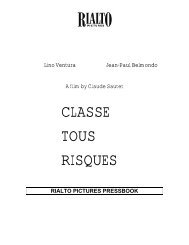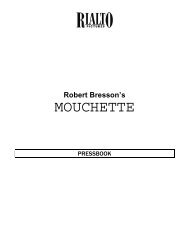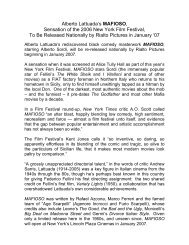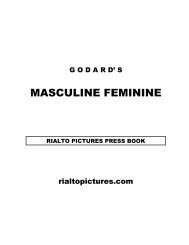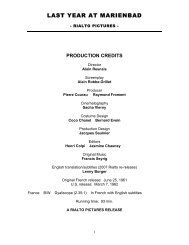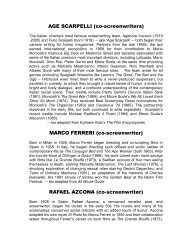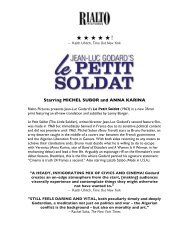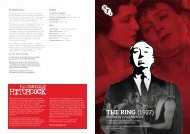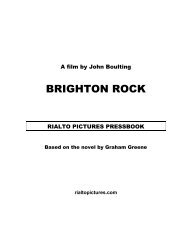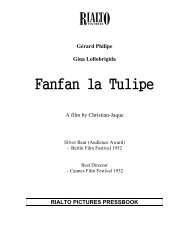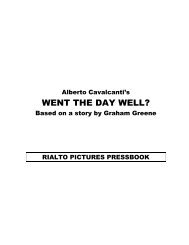download Diary of a Country Priest pressbook - Rialto Pictures
download Diary of a Country Priest pressbook - Rialto Pictures
download Diary of a Country Priest pressbook - Rialto Pictures
Create successful ePaper yourself
Turn your PDF publications into a flip-book with our unique Google optimized e-Paper software.
RIALTO PICTURES PRESSBOOK
DIARY OF A COUNTRY PRIEST<br />
- RIALTO PICTURES -<br />
Writer/Director<br />
Robert Bresson<br />
from the novel Le Journal d’un Curé de Campagne by<br />
Georges Bernanos<br />
Producer<br />
Léon Carré<br />
Cinematography<br />
Léonce-Henri Burel<br />
Camera Operator<br />
Robert Juillard<br />
Assistant Director<br />
Guy Lefranc<br />
Editor<br />
Paulette Robert<br />
Music<br />
Jean-Jacques Grunenwald<br />
Sound<br />
Jean Rieul<br />
English translation/subtitles (2011)<br />
Lenny Borger<br />
Subtitle Editors (2011)<br />
Bruce Goldstein<br />
Adrienne Halpern<br />
A Union Générale Cinématographique Production<br />
A RIALTO PICTURES RELEASE<br />
Shooting: March 6–June 19, 1950<br />
Pas-de-Calais (France)<br />
First Release: February 7, 1951 (Paris)<br />
France Black and White Aspect ratio: 1.33:1<br />
Running time: 115 min.<br />
2
DIARY OF A COUNTRY PRIEST<br />
- RIALTO PICTURES -<br />
CAST<br />
The <strong>Priest</strong> <strong>of</strong> Ambricourt<br />
Claude Laydu<br />
The Count<br />
Jean Riveyre<br />
The Countess<br />
Marie-Monique Arkell<br />
The <strong>Priest</strong> <strong>of</strong> Torcy<br />
André Guibert<br />
Doctor Delbende<br />
Antoine Balpetré<br />
Chantal<br />
Nicole Ladmiral<br />
Seraphita<br />
Martine Lemaire<br />
Louise<br />
Nicole Maurey<br />
The Canon<br />
Gaston Séverin<br />
Olivier<br />
Jean Danet<br />
Louis Dufréty<br />
Bernard Hubrenne<br />
Housekeeper<br />
Jeanne Etiévant<br />
3
DIARY OF A COUNTRY PRIEST<br />
- RIALTO PICTURES -<br />
WHAT THE CRITICS HAVE SAID ABOUT<br />
DIARY OF A COUNTRY PRIEST<br />
"A pure and intense account <strong>of</strong> the anguish <strong>of</strong> a young priest whose faith is neither<br />
understood nor accepted by his village. An austere director <strong>of</strong> astonishing integrity,<br />
Bresson <strong>of</strong>fers no sops to the public -- no humorous or romantic asides; he pulls<br />
you down into the depths <strong>of</strong> the priest's suffering and refuses to give you a glad<br />
hand up. What he does <strong>of</strong>fer is one <strong>of</strong> the most pr<strong>of</strong>ound emotional<br />
experiences in the history <strong>of</strong> film; no other director, with the possible exception<br />
<strong>of</strong> Dreyer with The Passion <strong>of</strong> Joan <strong>of</strong> Arc, has come so close to communicating a<br />
religious experience." – Pauline Kael<br />
“Bresson at his greatest... [builds] a pr<strong>of</strong>ound sense <strong>of</strong> a higher order through its<br />
relentless detailing <strong>of</strong> the cold, small facts <strong>of</strong> everyday life. A masterpiece,<br />
beyond question.” – Dave Kehr<br />
“Watching this spiritual odyssey is almost a religious experience in itself, but<br />
one which has nothing to do with faith or dogma, everything to do with Bresson’s<br />
unique ability to exteriorize an interior world.” – Time Out (London)<br />
“This one movie changed my life... by putting me in contact with a habit <strong>of</strong> mind<br />
that I may as well call spiritual, and a mental process suspiciously like meditation.”<br />
– Philip Lopate<br />
"A masterpiece with an almost physical impact...It moves the critic and the<br />
uncritical alike primarily because <strong>of</strong> its power to stir the emotions at their highest<br />
level <strong>of</strong> sensitivity." – André Bazin<br />
"Bresson’s best film. Every shot is as true as a handful <strong>of</strong> earth."<br />
– François Truffaut<br />
Awards<br />
Prix Louis Delluc (Best French Film)<br />
Grand Prix du Cinéma Français 1<br />
International Award, Venice Film Festival 2<br />
Best Cinematography, Venice Film Festival<br />
International Catholic Film Office Award, Venice Film Festival<br />
Italian Film Critics Award, Venice Film Festival<br />
French Film Critics Award (Prix Méliès)<br />
1 At the time, this was France’s equivalent to the Best Picture Oscar. The award, last given in<br />
1984, was subsequently replaced in importance by the César.<br />
2 It was also nominated for the Golden Lion.<br />
4
DIARY OF A COUNTRY PRIEST<br />
- RIALTO PICTURES -<br />
SYNOPSIS<br />
A young but sickly priest, fresh out <strong>of</strong> the seminary, arrives in Ambricourt, a<br />
modest village in a gloomy corner <strong>of</strong> northwestern France, to take charge <strong>of</strong> his<br />
first parish. The parish is poor, the rectory devoid <strong>of</strong> the most basic amenities. The<br />
parishioners are at best indifferent or suspicious. These include the local peasants<br />
and the nobility who live at the Chateau: the Count, the Countess, their daughter<br />
Chantal, and the governess, Miss Louise.<br />
It doesn’t take long for the young priest to realize that the locals have little<br />
sympathy for him and even less spiritual feeling. Though he thinks he’s found an<br />
ally in the Count, his illusions are quickly crushed. He’s distressed when a miserly<br />
old peasant comes to quibble bitterly over the price <strong>of</strong> his wife’s funeral. And in<br />
catechism class, even the most studious <strong>of</strong> the young girls, Seraphita, seems<br />
interested only in making fun <strong>of</strong> him. His only support is his older colleague, the<br />
parish priest <strong>of</strong> Torcy, a gruff but warm-hearted cleric.<br />
Through Miss Louise, the governess at the Chateau, who regularly attends church,<br />
the priest learns about the Count’s family. Since the death <strong>of</strong> a first child, the<br />
Countess has lived in reclusive sorrow. Her daughter Chantal is a proud young<br />
woman who seems to take pleasure in humiliating Miss Louise. The priest soon<br />
understands that the Chateau is full <strong>of</strong> secrets. The Countess has lost her faith and<br />
seems to hold God personally responsible for her misfortune. And if Chantal<br />
thrives on hatred, it’s because she knows that the governess has become her<br />
father’s mistress. Her goal is to seek revenge, expel this woman, do harm for<br />
harm’s sake.<br />
Ambricourt, then, is a spiritual wasteland where all is resentment, despair and<br />
pride... and no place for forgiveness or love. The priest is himself so weak, so<br />
clumsy, he can bring no peace to all this suffering or lead these stray souls back to<br />
God. Suffering himself from stomach pains, he hasn’t enough strength to fight.<br />
And yet, despite his poor health, his own doubts and lack <strong>of</strong> experience, the priest<br />
attempts the impossible. Though Chantal withdraws into her shell <strong>of</strong> pride, he<br />
succeeds, after a dramatic confrontation, in bringing the Countess around to<br />
resignation and reborn faith. But no one will know <strong>of</strong> this victory, other than God.<br />
Shortly after the priest’s visit, the Countess dies and he’s expelled from the<br />
Chateau, as if he were responsible for her death. What good would it do to say that<br />
he had saved her for Eternity?<br />
And who will believe him capable or judge him worthy, now that it is known that his<br />
diet consists <strong>of</strong> stale bread and cheap wine; this man <strong>of</strong> God is nothing but a<br />
drunkard.<br />
5
DIARY OF A COUNTRY PRIEST<br />
- RIALTO PICTURES -<br />
His stomach pains now unbearable, the priest consults a specialist in Lille. He is<br />
diagnosed with stomach cancer. He pays a visit to a former seminary schoolmate<br />
who has abandoned his vows and now lives with a woman he’s not married to. The<br />
priest dies in their shabby apartment, without having received last rites.<br />
This is his final trial. “What does it matter?” he says in his last breath. “All is grace.”<br />
DIARY OF A COUNTRY PRIEST: BACKGROUND<br />
The first screen adaptation <strong>of</strong> the Bernanos novel was by Jean Aurenche and<br />
Pierre Bost 3 , “the prettifiers and popularizers <strong>of</strong> literary classics.” In his first major<br />
essay, "A Certain Tendency in French Cinema,” François Truffaut turned <strong>Diary</strong> <strong>of</strong> a<br />
<strong>Country</strong> <strong>Priest</strong> into a cause célèbre: “With delectation, Truffaut recounts the<br />
humiliating reception Aurenche and Bost’s script was given by the novel’s author<br />
shortly before his death in 1948 and the joy thereafter… when Robert Bresson’s<br />
version was accepted enthusiastically.”<br />
While excoriating the liberties taken with his novel [by Aurench and Bost],<br />
Bernanos encouraged other scenarists to try their hand at “dreaming his novel<br />
over again in the language <strong>of</strong> cinema,” for he had been genuinely excited by the<br />
idea <strong>of</strong> the adaptation, especially since Jean-Louis Barrault wanted the lead role<br />
desperately, and Bernanos had loved him in Children <strong>of</strong> Paradise (1945)…<br />
It was in 1948 that Bresson began to compose his version at the behest <strong>of</strong> an<br />
ambitious young producer, Pierre Gérin. With Bernanos’s death in July 1948,<br />
however, and after a perusal <strong>of</strong> Bresson’s austere and unconventional script, Gérin<br />
pulled out and sold his rights to Bresson. When Bernanos’s literary executor,<br />
Albert Béguin, accepted Bresson’s proposal, the French national production<br />
agency, Union Général du Cinéma, agreed to back the film as a special one-time<br />
venture.<br />
…Bresson chose for his hero a young Swiss actor from among a great many<br />
candidates, all practicing Catholics. For over a year Bresson and [Claude] Laydu<br />
met each Sunday to discuss the role. Laydu lived for a time in a monastery to<br />
accustom himself to priestly gestures so that he would, in Bresson’s formulation,<br />
no longer be an actor but a model, a pure form, unconscious and instinctive, to be<br />
sculpted by light and camera.<br />
Most <strong>of</strong> the other actors were nonpr<strong>of</strong>essionals, usually acquaintances with whose<br />
faces Bresson felt familiar. The shooting…took place in the precise area <strong>of</strong><br />
3 Known for their literary adaptations and later attacked by the New Wave as architects <strong>of</strong> the<br />
“cinema <strong>of</strong> quality,” Aurenche and Bost collaborated on the screenplays for more than 30 films,<br />
including Devil in the Flesh (1945), La Symphonie Pastorale (1946) and Forbidden Games (1951).<br />
6
DIARY OF A COUNTRY PRIEST<br />
- RIALTO PICTURES -<br />
Bernanos’s ancestral home, the north coast <strong>of</strong> Calais. Plagued with<br />
uncharacteristically sunny weather, Bresson worked endlessly on the minutiae <strong>of</strong><br />
the indoor sequences, all <strong>of</strong> which were shot in the buildings <strong>of</strong> the area.<br />
The French press covered the making and premiere <strong>of</strong> the film with awe and pride.<br />
They helped guide it to a new audience consisting <strong>of</strong> intellectuals and the pious –<br />
people who seldom went to the cinema. They also encouraged cinephiles to see<br />
this particular film more than once. In this way <strong>Diary</strong> <strong>of</strong> a <strong>Country</strong> <strong>Priest</strong> opened up<br />
new options in the conception, realization, and exploitation <strong>of</strong> a film, options which<br />
would be occasionally exercised only a decade later by the directors <strong>of</strong> the New<br />
Wave.<br />
Excerpted from “Desperation and Meditation” by Dudley Andrew, published in Modern<br />
European Filmmakers and the Art <strong>of</strong> Adaption, eds. Andrew Horton and Joan Margetta<br />
(Frederick Ungar Publishing Co., New York, 1981).<br />
BRESSON ON DIARY OF A COUNTRY PRIEST<br />
The following interview was conducted by journalist Jean Douchet in 1950<br />
on the set <strong>of</strong> <strong>Diary</strong> <strong>of</strong> a <strong>Country</strong> <strong>Priest</strong>:<br />
The <strong>Diary</strong> <strong>of</strong> a <strong>Country</strong> <strong>Priest</strong> unit is installed in the half-empty chateau <strong>of</strong> the Due<br />
de Reggio. Today, they’re shooting in an annex, a little house <strong>of</strong> white stone that<br />
stands out against the red brick <strong>of</strong> the village. The rooms inside were so small that<br />
the walls had to be knocked down in order to shoot. One <strong>of</strong> these rooms now<br />
represents the rectory kitchen. The next room is jammed with the unit’s<br />
equipment: camera, tracks, etc.<br />
Bresson, very calm, superintends the lighting. Of medium height, distinguished<br />
appearance, graying hair, he bears little resemblance to the director <strong>of</strong> legend.<br />
One’s first impression is <strong>of</strong> a chilly and self-confident intellectual. But you soon<br />
notice his restlessness, his dissatisfaction.<br />
We’ve reached the point where the Countess has just sent the priest a letter and a<br />
locket – a souvenir <strong>of</strong> her dead child. This morning, I’m to see the reading <strong>of</strong> the<br />
letter. The set is quickly lit; a simple emphasis on the priest, seated at his kitchen<br />
table, the letter he holds in his left hand and the locket in his right, a few objects<br />
strewn over the table: his notebooks, a missal, some crusts <strong>of</strong> bread.<br />
Behind him, the cook is standing by the fireplace; the walls are white and bare.<br />
Bresson comes up to his actor, Claude Laydu, who has been studying the script.<br />
He makes him read it. He calls for a choke in the voice, a halting delivery, long<br />
pauses. “Don’t forget that this letter has an intense emotional effect on you.” (He<br />
frequently begs for this intensity during the shooting.) Bresson works on the actor<br />
7
DIARY OF A COUNTRY PRIEST<br />
- RIALTO PICTURES -<br />
as the sculptor models his clay. Then he goes on to the action: seated on the<br />
truck, facing the actor, he demonstrates the gestures he wants. First <strong>of</strong> all, a<br />
simple detail: the letter must be folded in such a way that the camera can see its<br />
black edges—for the countess is still in mourning for her son. Laydu must sit up<br />
straight, assume the expression <strong>of</strong> a man deeply stirred, yet still in control <strong>of</strong><br />
himself. In his right hand he’s to finger the chain <strong>of</strong> the locket. In one <strong>of</strong> his<br />
pauses, he must let it slip through his fingers, then gather it up again. Here the<br />
camera tracks back, shortly and sharply. When perfect coordination is achieved<br />
between the reading <strong>of</strong> the letter, the actor’s gestures, and the camera movement,<br />
shooting can begin. The shot is captured after twenty-four false starts.<br />
Work like this is exhausting for the actor. Last night, a female cast member<br />
apparently fainted during a take. And this wasn’t the first such incident; no one<br />
can keep count <strong>of</strong> the crises de nerfs. 4 I witness a violent altercation between the<br />
calm Bresson and the gentle Laydu. The director tortures his players – not to force<br />
from them all that they’re capable <strong>of</strong>, but so as to leave nothing to their own<br />
initiative. Laydu tells me <strong>of</strong> his weariness, and I sense acutely the actor’s revulsion<br />
to his director’s methods. As for the rest <strong>of</strong> the unit, apart from the sound engineer,<br />
they’re reduced to a semi-inactivity, with the result that their attitude toward the<br />
director has hardened into a sort <strong>of</strong> ironic hostility – accentuated by the fact that<br />
this unit is a homogeneous body, working together now on their third or fourth film.<br />
But Bresson remains unaffected.<br />
I take advantage <strong>of</strong> the lunch break to interview Monsieur Bresson.<br />
What has been your approach to Bernanos’s novel?<br />
Respectful – <strong>of</strong> its construction, propositions, etc. I’ve taken most <strong>of</strong> the dialogue<br />
from the book.<br />
We went on to talk <strong>of</strong> the film’s style.<br />
Very plain. The photography is simple: no effects; no sophistication.<br />
You’re seeking an abstract style – something like Dreyer’s? 5<br />
I have no theory. As far as possible, I try to eliminate anything that may distract<br />
from the interior drama.<br />
You’re shooting against natural backgrounds. Does that mean that you<br />
attach special importance to them?<br />
4 Crises de nerfs: hysterics<br />
5 Carl Theodor Dreyer made the silent masterpiece The Passion <strong>of</strong> Joan <strong>of</strong> Arc and other stark<br />
films about faith.<br />
8
DIARY OF A COUNTRY PRIEST<br />
- RIALTO PICTURES -<br />
The natural backgrounds will be very little seen, but their presence will be known,<br />
and that’s enough.<br />
On what portion <strong>of</strong> the novel have you based your adaptation? It’s hardly<br />
more than a prolonged meditation. [This made him start, as I thought it<br />
would.]<br />
To me, the cinema is an exploration within. Within the mind, the camera can grasp<br />
anything.<br />
Judging by Les dames du Bois de Boulogne 6 , you place great importance on<br />
sound.<br />
Certainly.<br />
Have you had many difficulties in the making <strong>of</strong> this film?<br />
Oh? [as in “What do you mean?”].<br />
I don’t dare venture any further, being quite sure that it wasn’t just a matter<br />
<strong>of</strong> material struggles.<br />
Excerpted from “Bresson on Location” by Jean Douchet, first published in Sequence #13,<br />
1951, reprinted in The Films <strong>of</strong> Robert Bresson: A Casebook, ed. Bert Cardullo (Anthem<br />
Press, London, 2009).<br />
ANDRE BAZIN 7 ON DIARY OF A COUNTRY PRIEST<br />
If The <strong>Diary</strong> <strong>of</strong> a <strong>Country</strong> <strong>Priest</strong> impresses us as a masterpiece, and this with an<br />
almost physical impact, if it moves the critic and the uncritical alike, it is primarily<br />
because <strong>of</strong> its power to stir the emotions, rather than the intelligence, at their<br />
highest level <strong>of</strong> sensitivity…<br />
We find the critical field divided into two extreme groups. At one end those least<br />
equipped to understand <strong>Diary</strong> and who, by the same token, have loved it all the<br />
more without knowing why; at the other end those "happy few" who, expecting<br />
something different, have not liked it and have failed to understand it. It is the<br />
strangers to the cinema, the men <strong>of</strong> letters, amazed that they could so love a film<br />
and be capable <strong>of</strong> freeing their minds <strong>of</strong> prejudice, who have understood what<br />
Bresson had in mind more clearly than anyone else.<br />
6 Bresson’s second film, released in 1945.<br />
7 Bazin (1918-1958) was one <strong>of</strong> France’s most influential film critics and theorists. Among his<br />
disciples was François Truffaut, who dedicated his first feature, The 400 Blows, to Bazin’s memory.<br />
9
DIARY OF A COUNTRY PRIEST<br />
- RIALTO PICTURES -<br />
Admittedly, Bresson has done his best to cover his tracks. His avowal <strong>of</strong> fidelity to<br />
the original from the first moment he embarked on the adaptation, his declared<br />
intention <strong>of</strong> following the book word for word, conditioned us to look for just that,<br />
and the film only serves to prove it... He prunes even the very essentials, giving an<br />
impression as he does so <strong>of</strong> a fidelity unable to sacrifice one single word without a<br />
pucker <strong>of</strong> concern and a thousand preliminary twinges <strong>of</strong> remorse. Again, this<br />
pruning is always in the interest <strong>of</strong> simplification, never <strong>of</strong> addition. It is no<br />
exaggeration to say that if Bernanos had written the screenplay he would have<br />
taken greater liberties with his novel. He had, indeed, explicitly recognized the right<br />
<strong>of</strong> the adaptor to make use <strong>of</strong> his book according to the requirements <strong>of</strong> the<br />
cinema—he had the right, that is, "to dream his story over."…<br />
If he had really been faithful to the book, Bresson would have made quite a<br />
different film. Determined though he was to add nothing to the original—already a<br />
subtle form <strong>of</strong> betrayal by omission—he might at least have chosen to sacrifice the<br />
more literary parts for the many passages <strong>of</strong> ready-made film material that cried<br />
out for visualization. Yet he systematically took the opposite course. When you<br />
compare the two, it is the film that is literary while the novel teems with visual<br />
material…<br />
The pattern <strong>of</strong> the film's unfolding is not that <strong>of</strong> tragedy in the usual sense, but<br />
rather in the sense <strong>of</strong> the medieval Passion Play, or better still, <strong>of</strong> the Way <strong>of</strong> the<br />
Cross, each sequence being a station along that road. We are given the key to this<br />
particular truth by the dialogue in the hut between the two curés, when the one<br />
from Ambricourt reveals that he is spiritually attracted to the Mount <strong>of</strong> Olives. …<br />
Bresson never condenses the text; he cuts it. Thus what is left over is a part <strong>of</strong> the<br />
original. Like marble from a quarry, the words <strong>of</strong> the film continue to be part <strong>of</strong> the<br />
novel. Of course the deliberate emphasis on their literary character can be<br />
interpreted as a search after artistic stylization, which is the very opposite <strong>of</strong><br />
realism...<br />
It is unlikely that there exists anywhere in the whole <strong>of</strong> French cinema, perhaps<br />
even in all French literature, many moments <strong>of</strong> more intense beauty than in the<br />
medallion scene between the curé and the countess. Its beauty does not derive<br />
from the acting or from the psychological and dramatic values <strong>of</strong> the dialogue, nor<br />
indeed does it derive from the scene's intrinsic meaning. The true dialogue that<br />
punctuates the struggle between the inspired priest and a soul in despair is, <strong>of</strong> its<br />
very nature, ineffable. The decisive clashes <strong>of</strong> their spiritual fencing match<br />
therefore escape us. Their words announce, or prepare the way for, the fiery touch<br />
<strong>of</strong> grace…<br />
Bresson disposes once and for all <strong>of</strong> that commonplace <strong>of</strong> criticism according to<br />
which image and sound should never duplicate each other. The most moving<br />
moments in the film are those in which text and image are saying the same thing,<br />
10
DIARY OF A COUNTRY PRIEST<br />
- RIALTO PICTURES -<br />
each, however, in its own way. The sound never serves simply to fill out what we<br />
see. It strengthens what we see and multiplies it, just as the echo chamber <strong>of</strong> a<br />
violin echoes and multiplies the vibrations <strong>of</strong> the strings…<br />
It would be futile to look for <strong>Diary</strong>'s devastating beauty simply in what is explicit. I<br />
doubt if the individual frames in any other film, taken separately, are so deceptive...<br />
Up to now, film tended to substitute for the novel in the guise <strong>of</strong> its aesthetic<br />
translation into another language… <strong>Diary</strong>, however, is something else again…<br />
There is no question here <strong>of</strong> a translation, no matter how faithful or intelligent. Still<br />
less is it a question <strong>of</strong> free inspiration with the intention <strong>of</strong> making a duplicate. It is<br />
a question <strong>of</strong> building a secondary work with the novel as foundation. In no sense<br />
is the film "comparable" to the novel or "worthy" <strong>of</strong> it. It is a new aesthetic creation,<br />
the novel so to speak multiplied by the cinema.<br />
Excerpted from “<strong>Diary</strong> <strong>of</strong> a <strong>Country</strong> <strong>Priest</strong> and the Stylistics <strong>of</strong> Robert Bresson” by André<br />
Bazin, from Cahiers du cinema #3 (1951); translated by Hugh Gray in Bazin’s What is<br />
Cinema? (Berkeley, University <strong>of</strong> California Press, 1967)<br />
ROBERT BRESSON (Director/Writer)<br />
The known facts <strong>of</strong> Robert Bresson’s life are as elliptical and mysterious as many<br />
<strong>of</strong> his films. Though his <strong>of</strong>ficial year <strong>of</strong> birth was 1907, he was in fact born in 1901,<br />
in Bromont-Lamothe, in the Auvergne region, the son <strong>of</strong> a military <strong>of</strong>ficer. His first<br />
vocations were painting and, occasionally, photography.<br />
He entered the film industry in the early 30s, working as a screenwriter and<br />
assistant on a handful <strong>of</strong> films. In view <strong>of</strong> his later career, Bresson made one <strong>of</strong> the<br />
most surprising <strong>of</strong> writing-directing debuts in 1934. Les Affaires publiques was a<br />
medium-length screen farce, which featured a famous clown named Béby (the<br />
subject <strong>of</strong> Jean-Pierre Melville’s first film short in 1946) and future Grand Illusion<br />
player Marcel Dalio. Long believed lost, it was rediscovered (in a truncated<br />
version) at the Cinémathèque Française in the mid-80s. Fifty years later, Bresson<br />
remarked: “Seeing it again, I was surprised to more or less find the way I seize on<br />
things and put them together, the way in which the shots follow one another.”<br />
Bresson had to wait another decade before making his feature film debut. After<br />
being a POW, he returned to Occupied Paris to find backers for his film projects.<br />
His first two films had distinctive literary pedigrees: Les Anges du péché (1943), a<br />
spiritual melodrama set in a convent, was scripted by Jean Giraudoux, and Les<br />
Dames du Bois de Boulogne (1944-45), was adapted by Jean Cocteau from<br />
Diderot’s Jacques le Fataliste. Both were cast with pr<strong>of</strong>essional actors, against<br />
whom Bresson would revolt beginning with his next film, <strong>Diary</strong> <strong>of</strong> a <strong>Country</strong> <strong>Priest</strong><br />
(1951), an adaptation <strong>of</strong> Georges Bernanos’s novel that brought the filmmaker to<br />
international attention. <strong>Diary</strong> marked the birth <strong>of</strong> Bresson’s ascetically mature<br />
11
DIARY OF A COUNTRY PRIEST<br />
- RIALTO PICTURES -<br />
screen style. By the end <strong>of</strong> the decade, Bresson produced two other masterpieces,<br />
A Man Escaped (1956), an extraordinary blend <strong>of</strong> prison escape movie suspense<br />
and spiritual quest no doubt enriched by his own experiences as a POW, and<br />
Pickpocket (1959), the first film for which Bresson wrote an original scenario not<br />
adapted from a pre-existing work.<br />
Bresson’s next film, The Trial <strong>of</strong> Joan <strong>of</strong> Arc (1962) is <strong>of</strong>ten considered to be his<br />
least successful film, its austerity making Dreyer’s version seem lavish by<br />
comparison. On the other hand, Bresson reached his critically acclaimed apogee<br />
with Au Hasard Balthazar (1966) and Mouchette (1967), the latter again based on<br />
a Bernanos novel 8 . He turned to Dostoevsky for the plots <strong>of</strong> his next two films:<br />
Une femme douce (1969) was his first in color and introduced French actress<br />
Dominique Sanda, and Four Nights <strong>of</strong> a Dreamer (1972).<br />
Lancelot <strong>of</strong> the Lake (1974) was Bresson’s second period recreation (after Joan <strong>of</strong><br />
Arc) and also divided the critics. Nor was The Devil Probably (1977) rated among<br />
Bresson’s finest works. Bresson was 81 when he made his last film, L’Argent<br />
(1982), based on a Tolstoy novella. Shown at the 1983 Cannes Film Festival, it<br />
shared a consolation prize (the Grand Prix du Cinéma de Création) with Andrei<br />
Tarkovsky’s Nostalghia 9 . During the 80s, Bresson tried in vain to mount a<br />
production <strong>of</strong> Genesis, a re-telling <strong>of</strong> the Bible.<br />
Bresson published a volume <strong>of</strong> observations and aphorisms on the cinema in<br />
1975, Notes sur le cinématographe (inaccurately translated as Notes on the<br />
Cinematographer in its English language edition).<br />
Robert Bresson died on December 18, 1999 at the age <strong>of</strong> 98.<br />
GEORGES BERNANOS (Author)<br />
Georges Bernanos was a French Catholic author whose works explored the<br />
principals <strong>of</strong> Christianity through the spiritual conflicts <strong>of</strong> his characters. He served<br />
in World War I and was wounded several times. He wrote his first book, Sous le<br />
soleil de Satan, in 1926.<br />
<strong>Diary</strong> <strong>of</strong> a <strong>Country</strong> <strong>Priest</strong> was written during a dark period <strong>of</strong> Bernanos’s life. He<br />
suffered a serious motorcycle accident, which left him crippled and with financial<br />
difficulties and creative uncertainty. In 1934, he suddenly left France to live in<br />
Majorca, where <strong>Diary</strong> was written. Published in 1936, it won the Grand Prix du<br />
Roman de l’Académie Française 10 .<br />
8 Nouvelle histoire de Mouchette. Both Balthazar and Mouchette have been reissued by <strong>Rialto</strong>.<br />
9 Ironically, Tarkovsky was an ardent admirer <strong>of</strong> Bresson’s work and called <strong>Diary</strong> <strong>of</strong> a <strong>Country</strong><br />
<strong>Priest</strong> his favorite film.<br />
10 Grand prize for the best novel <strong>of</strong> the year, awarded by the prestigious French Academy.<br />
12
DIARY OF A COUNTRY PRIEST<br />
- RIALTO PICTURES -<br />
An initial supporter <strong>of</strong> Franco, he became disillusioned with the future dictator after<br />
witnessing the Spanish Civil War. Perceiving the danger <strong>of</strong> war throughout Europe,<br />
he emigrated to South America and lived mostly in Brazil until after World War II,<br />
though his sons returned to France to fight. He was critical <strong>of</strong> the Vichy regime<br />
and supported the Resistance. After the liberation, Charles de Gaulle invited him<br />
back to France to take a government post. Bernanos returned, but not to politics.<br />
He died in 1948. In addition to <strong>Diary</strong>, two <strong>of</strong> his books were adapted to the screen:<br />
Sous le soleil de Satan, filmed by Maurice Pialat in 1987, and Nouvelle histoire de<br />
Mouchette (1937), which became Bresson’s Mouchette.<br />
In his book Bernanos: His Political Thought and Philosophy, Thomas Steven<br />
Molnar writes, “The world <strong>of</strong> Bernanos’s novels reflects his main preoccupation:<br />
what is the position <strong>of</strong> the saint in a world teeming with the most complicated, the<br />
most sophisticated forms <strong>of</strong> evil? But, first <strong>of</strong> all, who is a saint? and what is evil?<br />
What happens when these two poles <strong>of</strong> spirituality come into contact? These are<br />
the problems that Bernanos peruses in all his works – in his political writings as<br />
well as in his novels. The spiritual man is not a strictly religious phenomenon; he<br />
is, rather, the man with a positive life whose being is heavy with the weight <strong>of</strong> God<br />
in him. He may be a simple peasant, a public figure, a young girl or a priest; in<br />
each case his life is centered on an Existence that is infinitely higher than his own.”<br />
In Bernanos: An Ecclesiastical Existence, Hans Urs von Balthasar writes: “What<br />
makes him a creator <strong>of</strong> Christian literature is not the fact that he daily went to<br />
Mass, or, if he couldn’t, that he prayed the texts <strong>of</strong> the Mass at home, that he went<br />
to confession every week… What made him a Christian writer was that he did<br />
these things with a conviction that welled up from the deepest parts <strong>of</strong> his being ...”<br />
In 1935, Bernanos wrote to Madame de La Noue, who believed that he based the<br />
character <strong>of</strong> <strong>Country</strong> <strong>Priest</strong>’s Count on her father, a landowner near Fressins, the<br />
village where Bernanos was raised: “I began <strong>Diary</strong> one evening last winter, having<br />
absolutely no idea where I was going with it. How many novels have I begun in this<br />
way, which never got past page twenty because they weren’t taking me anywhere!<br />
No matter! As soon as I take pen in hand, what at once begins emerging before<br />
me is my childhood, a very ordinary childhood like all others; and yet, it is from it<br />
that I draw everything I write as from an inexhaustible fountain <strong>of</strong> dreams: the<br />
faces and landscapes <strong>of</strong> my childhood, all mixed up, confused, shuffled helterskelter<br />
by this peculiar unconscious memory that makes me what I am – a novelist<br />
and God willing, also a poet… From a certain moment on, I’m not inventing<br />
anything: I simply retell what I am seeing. People I have loved pass before me on<br />
the screen, and I recognize them only a long time afterward when they have<br />
already stopped acting and speaking. Or it happens that I don’t recognize them at<br />
all, because they’ve been transformed little by little, forming, in conjunction with<br />
others, part <strong>of</strong> an imaginary creation more real to me than any living person.” 11<br />
11 Letter to Madame de la Noue (1935), quoted in Bernanos: An Ecclesiastical Existence by Hans<br />
Urs von Balthasar<br />
13
DIARY OF A COUNTRY PRIEST<br />
- RIALTO PICTURES -<br />
CLAUDE LAYDU (The <strong>Priest</strong> <strong>of</strong> Ambricourt)<br />
Born in Brussels to Swiss parents in 1927, Claude Laydu studied acting with Jean-<br />
Louis Barrault 12 . He made his pr<strong>of</strong>essional debut in the company <strong>of</strong> Jean Dasté<br />
before being tested and cast by Bresson for the title role <strong>of</strong> <strong>Diary</strong> <strong>of</strong> a <strong>Country</strong><br />
<strong>Priest</strong>. His performance brought him international acclaim, as well as a best actor<br />
prize awarded by the Ciné-Revue magazine and a BAFTA nomination as Best<br />
Foreign Actor. His career continued in a minor key throughout the decade with<br />
supporting roles in such films as André Cayatte’s We Are All Murderers and<br />
Philippe Agostini and R. L. Bruckberger’s Dialogue <strong>of</strong> the Carmelites. In the early<br />
60s, Laydu pioneered children’s television programming when he created and<br />
produced the long-running “Bonne Nuit les Petits,” a nightly series <strong>of</strong> five-minute<br />
vignettes performed by marionettes and designed to prepare children for bed.<br />
ANDRE GUIBERT (The <strong>Priest</strong> <strong>of</strong> Torcy)<br />
As the tender-tough <strong>Priest</strong> <strong>of</strong> Torcy, Bresson cast the non-pr<strong>of</strong>essional Guibert,<br />
pseudonym for Adrien Borel (1886-1966), a distinguished Freudian psychoanalyst.<br />
Borel at first rejected Bresson’s proposal, but the director wouldn’t take no for an<br />
answer. Borel finally agreed to take the part provided his real name not be used.<br />
JEAN RIVEYRE (the Count)<br />
A theatre administrator and minor actor, Riveyre (1904 - ?) seemed cut out to play<br />
a nobleman: his real name was Jean Bussard-Bivert de Saint-Araille. He played a<br />
hotel clerk in a key scene in Jacques Becker’s Touchez Pas Au Grisbi and<br />
appeared in several other Becker films.<br />
ANTOINE BALPETRE (Dr. Delbende)<br />
A familiar character actor in French films <strong>of</strong> the 40s and 50s, Balpetré (1898-1963)<br />
was a member <strong>of</strong> the Comédie Française from 1934 to1945. He played in the first<br />
films <strong>of</strong> Henri-Georges Clouzot and was a staple figure in André Cayatte’s social<br />
dramas <strong>of</strong> the 50s. His stage credits included the role <strong>of</strong> Big Daddy in the French<br />
premiere <strong>of</strong> Cat on a Hot Tin Ro<strong>of</strong>, directed by Peter Brook (1956).<br />
12 One <strong>of</strong> France’s most beloved actors, Barrault is most famous to international audiences as the<br />
mime in Marcel Carné’s Les Enfants du paradis (Children <strong>of</strong> Paradise). Ironically, he’d desperately<br />
wanted the role <strong>of</strong> the priest himself.<br />
14
DIARY OF A COUNTRY PRIEST<br />
- RIALTO PICTURES -<br />
MARIE-MONIQUE ARKELL (the Countess)<br />
Marie-Monique Arkell was the real name <strong>of</strong> pr<strong>of</strong>essional stage actress Rachel<br />
Behrendt (1893-1957). First wife <strong>of</strong> fellow Conservatoire student Pierre Fresnay,<br />
she appeared in several silent films, notably Charles Burguet’s The Mysteries <strong>of</strong><br />
Paris (1922) and co-starred with Jean Gabin in Paris-Beguin (1931).<br />
NICOLE LADMIRAL (Chantal)<br />
Born in 1930, Ladmiral, who played the suicide-obsessed Count’s daughter with<br />
frightening intensity, threw herself under a Métro train in 1958. Before appearing in<br />
<strong>Diary</strong>, she co–narrated, with Georges Hubert, Georges Franju’s first film, a short<br />
documentary on slaughterhouses, Le sang des bêtes (1948). She had a minor<br />
role in Deux sous de violettes (1951) directed by Jean Anouilh. Jean-Luc Godard<br />
dedicated an episode <strong>of</strong> Histoire(s) du Cinema titled Fatale beauté (1997) to two<br />
women, one <strong>of</strong> whom was Nicole Ladmiral.<br />
NICOLE MAUREY (Louise)<br />
Born in 1925 in a suburb <strong>of</strong> Paris, Maurey was a dancer before being cast in her<br />
first film in 1944, Le Cavalier noir. She acted in films in France until she was<br />
brought to Hollywood to appear alongside Bing Crosby in Little Boy Lost (1953).<br />
Her career never took <strong>of</strong>f, but she appeared in popular films such as Secret <strong>of</strong> the<br />
Incas (1954, alongside Charlton Heston), Me and the Colonel (1958, with Danny<br />
Kaye), and The Scapegoat (1959, with Bette Davis and Alec Guinness). She<br />
moved to England where she continued to act in films, the most notable, The Day<br />
<strong>of</strong> the Triffids (1962). She returned to France, focusing on television and madefor-TV<br />
movies, before retiring in 1997.<br />
15
DIARY OF A COUNTRY PRIEST<br />
- RIALTO PICTURES -<br />
LÉONCE-HENRI BUREL (cinematographer)<br />
In an extraordinary 50-year career bookended by collaborations with two <strong>of</strong><br />
France’s great directors, Abel Gance and Robert Bresson, L. H. Burel (1892-1977)<br />
was one <strong>of</strong> the most technically adventurous <strong>of</strong> lighting cameramen. He entered<br />
the Film d’Art studios in 1913 as a cameraman and in 1915 began working almost<br />
exclusively with Gance; he shot all the films <strong>of</strong> his first major period, including<br />
J’accuse (1919) and La Roue (1923). Initially unavailable for Napoléon (1925-26),<br />
he later joined Gance’s production unit as “technical director”. His other important<br />
collaboration <strong>of</strong> the time was with Jacques Feyder, most memorably on<br />
Crainquebille (1922) and Visages d’enfants (1923-25). He shot two period<br />
extravaganzas for Russian émigré star Ivan Mozzhukin, Michael Strog<strong>of</strong>f (1925)<br />
and Casanova (1926) and worked for Rex Ingram and Léonce Perret at the<br />
Victorine Studios in Nice. During the sound period, he provided superb images for<br />
many mediocre commercial pictures, but there were occasionally fine films with<br />
Henri Decoin, Jean-Benoit Levy and Julien Duvivier. His first film for Bresson was<br />
<strong>Diary</strong> <strong>of</strong> a <strong>Country</strong> <strong>Priest</strong>, for which he won the award for Best Cinematography at<br />
the Venice Film Festival. Bresson and Burel went on to collaborate on A Man<br />
Escaped (1956), Pickpocket (1958) and The Trial <strong>of</strong> Joan <strong>of</strong> Arc (1962).<br />
JEAN-JACQUES GRUNENWALD (composer)<br />
Jean-Jacques Grunenwald (1911–1982) was an internationally renowned concert<br />
organist and composer for piano, organ, and chamber orchestra. Between 1957<br />
and 1962, he recorded the complete organ works <strong>of</strong> Johann Sebastian Bach.<br />
Grunenwald began composing for the cinema with Bresson’s Les Anges du Péché<br />
(1943); they also collaborated on Les Dames du Bois de Boulogne (1945) and<br />
<strong>Diary</strong> <strong>of</strong> a <strong>Country</strong> <strong>Priest</strong>. He scored 23 features (and a number <strong>of</strong> shorts), many<br />
<strong>of</strong> them solemn psychological or spiritual dramas such as Maurice Cloche’s biopic<br />
Monsieur Vincent (1947) and Henri Decoin’s La Verité sur Bébé Donge (1951).<br />
LENNY BORGER (subtitles)<br />
<strong>Diary</strong> is translator/subtitler Lenny Borger’s 35 th collaboration with <strong>Rialto</strong> <strong>Pictures</strong>,<br />
which began with the 1999 re-release <strong>of</strong> Grand Illusion. A former Paris Variety<br />
correspondent, the Paris-based, Brooklyn-born expatriate has also subtitled recent<br />
films by Bertrand Tavernier, Jean-Luc Godard and Claude Chabrol and has written<br />
new titles for such classics as Rififi, Touchez pas au Grisbi, Contempt, The Battle<br />
<strong>of</strong> Algiers, Casque d’or, Le Corbeau, Rules <strong>of</strong> the Game, Les Demoiselles de<br />
Rochefort, Children <strong>of</strong> Paradise, Raymond Bernard’s Les Misérables, five Jean-<br />
Pierre Melville films released by <strong>Rialto</strong> (including Army <strong>of</strong> Shadows), and ten<br />
Godard films. Borger collaborated with Godard himself on the translation and<br />
subtitles for In Praise <strong>of</strong> Love and Notre Musique.<br />
16
DIARY OF A COUNTRY PRIEST<br />
- RIALTO PICTURES -<br />
RIALTO PICTURES<br />
Described as “the gold standard <strong>of</strong> reissue distributors” by Los Angeles<br />
Times/NPR film critic Kenneth Turan, <strong>Rialto</strong> <strong>Pictures</strong> was founded in 1997 by<br />
Bruce Goldstein. A year later, Adrienne Halpern joined him as partner. In 2002,<br />
Eric Di Bernardo became the company’s National Sales Director.<br />
<strong>Rialto</strong>’s past releases have included Renoir’s Grand Illusion; Carol Reed’s The<br />
Third Man; Fellini’s Nights <strong>of</strong> Cabiria; Jules Dassin’s Rififi; De Sica’s Umberto D;<br />
Godard’s Contempt, Band <strong>of</strong> Outsiders, Masculine Feminine and A Woman is a<br />
Woman; Julien Duvivier’s Pépé le Moko; Buñuel’s Discreet Charm <strong>of</strong> the<br />
Bourgeoisie, <strong>Diary</strong> <strong>of</strong> a Chambermaid, The Phantom <strong>of</strong> Liberty, The Milky Way and<br />
That Obscure Object <strong>of</strong> Desire; John Schlesinger’s Billy Liar; Clouzot’s Quai des<br />
Orfèvres; Mike Nichols’ The Graduate; The Maysles’ Grey Gardens; Mel Brooks’<br />
The Producers; Jacques Becker’s Touchez Pas Au Grisbi; Franju’s Eyes Without A<br />
Face; and Jean-Pierre Melville’s Bob le Flambeur and Le Cercle Rouge, for the<br />
first time in its uncut European version.<br />
Following Au Hasard Balthazar and Mouchette, <strong>Diary</strong> <strong>of</strong> a <strong>Country</strong> <strong>Priest</strong> is the<br />
third Bresson film released by <strong>Rialto</strong>.<br />
In 2002, the company released the critically acclaimed first-run film Murderous<br />
Maids, the chilling true story <strong>of</strong> two homicidal sisters, starring Sylvie Testud. <strong>Rialto</strong><br />
celebrated a record-breaking 2004 with the previously unreleased, original 1954<br />
Japanese version <strong>of</strong> Godzilla and Gillo Pontecorvo’s groundbreaking The Battle <strong>of</strong><br />
Algiers, which became one <strong>of</strong> the year’s top-grossing foreign films.<br />
In 2006, <strong>Rialto</strong> released Melville’s 1969 epic masterpiece Army <strong>of</strong> Shadows for the<br />
very first time in the U.S. Army <strong>of</strong> Shadows became the most critically acclaimed<br />
film <strong>of</strong> the year, topping many Ten Best lists, including those in The New York<br />
Times and Premiere, and was named Best Foreign Film <strong>of</strong> 2006 by the New York<br />
Film Critics’ Circle, in addition to receiving special awards from both the Los<br />
Angeles and National Society <strong>of</strong> Film Critics. <strong>Rialto</strong>’s re-release <strong>of</strong> Alberto<br />
Lattuada’s Mafioso, a dark comedy starring Alberto Sordi, was the unqualified<br />
highlight <strong>of</strong> the 2006 New York Film Festival. 2007 re-releases included Melville's<br />
Le Doulos, starring Jean-Paul Belmondo, and Jean-Jacques Beineix's "second<br />
wave" thriller Diva.<br />
In 2008, the company had phenomenal success with Alain Resnais' 1962 arthouse<br />
classic Last Year at Marienbad. <strong>Rialto</strong> also released Robert Hamer's rediscovered<br />
masterwork <strong>of</strong> “Brit Noir,” It Always Rains on Sunday, and undertook its second hit<br />
reissue <strong>of</strong> Godard's Contempt. Another successful re-release was Max Ophuls'<br />
legendary film Lola Montès in a definitive new 35mm restoration, which was<br />
showcased to enormous acclaim at the Cannes and Telluride Film Festivals and<br />
17
DIARY OF A COUNTRY PRIEST<br />
- RIALTO PICTURES -<br />
was the spotlight retrospective <strong>of</strong> the 2008 New York Film Festival.<br />
<strong>Rialto</strong>’s recent releases have included the U.S. premiere <strong>of</strong> Godard’s Made in<br />
U.S.A, the 40th anniversary re-release <strong>of</strong> Costa-Gavras’ Academy Award-winning<br />
political thriller Z, starring Yves Montand and Jean-Louis Trintignant, Jean-Pierre<br />
Melville’s legendary wartime drama Léon Morin, <strong>Priest</strong>, starring Jean-Paul<br />
Belmondo, and John Boulting’s Noir classic Brighton Rock, adapted from Graham<br />
Greene’s novel <strong>of</strong> the same name and starring Richard Attenborough.<br />
<strong>Rialto</strong> began 2010 with the 25th anniversary release <strong>of</strong> Ran in celebration <strong>of</strong> Akira<br />
Kurosawa’s centennial and followed it with the release <strong>of</strong> the 50th anniversary<br />
restoration <strong>of</strong> Godard's Breathless. Breathless was the company's 50th release<br />
since its founding.<br />
In 1999, <strong>Rialto</strong> received a special Heritage Award from the National Society <strong>of</strong> Film<br />
Critics, and in 2000 received a special award from the New York Film Critic’s<br />
Circle, presented to Goldstein and Halpern by Jeanne Moreau. The two copresidents<br />
have each received the French Order <strong>of</strong> Chevalier <strong>of</strong> Arts and Letters.<br />
2007 marked <strong>Rialto</strong>’s tenth anniversary, a milestone that was celebrated with a<br />
retrospective at the Museum <strong>of</strong> Modern Art in New York. Similar tributes were held<br />
at George Eastman House in Rochester, New York; the AFI Silver Theater in<br />
Washington, D.C.; and the SIFF Theater in Seattle. In May 2009, the San<br />
Francisco International Film Festival presented Goldstein with its prestigious Mel<br />
Novik<strong>of</strong>f Award.<br />
In addition to <strong>Diary</strong> <strong>of</strong> a <strong>Country</strong> <strong>Priest</strong>, the company’s 2011 releases include<br />
Public Speaking, Martin Scorsese’s portrait <strong>of</strong> humorist Fran Lebowitz (opening<br />
February 23 at Film Forum in New York), Nicolas Roeg’s The Man Who Fell to<br />
Earth, starring David Bowie, and Alberto Cavalcanti’s rediscovered wartime thriller<br />
Went the Day Well?, in a new restoration to be unveiled in April at the TCM Classic<br />
Film Festival in Hollywood.<br />
O<br />
18
DIARY OF A COUNTRY PRIEST<br />
- RIALTO PICTURES -<br />
RIALTO PICTURES RELEASES<br />
2011 DIARY OF A COUNTRY PRIEST<br />
PUBLIC SPEAKING<br />
WENT THE DAY WELL? (May)<br />
THE MAN WHO FELL TO EARTH (summer)<br />
2010 RAN<br />
BREATHLESS (50 TH Anniversary)<br />
2009 MADE IN USA (U.S. premiere)<br />
Z<br />
LEON MORIN, PRIEST<br />
BRIGHTON ROCK<br />
THE THIRD MAN (60th Anniversary)<br />
2008 LAST YEAR AT MARIENBAD<br />
IT ALWAYS RAINS ON SUNDAY<br />
CONTEMPT<br />
LOLA MONTES<br />
2007 MAFIOSO<br />
LE DOULOS<br />
DIVA<br />
2006 ARMY OF SHADOWS<br />
THE FALLEN IDOL<br />
FANFAN LA TULIPE<br />
TWO OR THREE THINGS I KNOW ABOUT HER<br />
2005 MASCULINE FEMININE<br />
ELEVATOR TO THE GALLOWS<br />
THE TWO OF US<br />
CLASSE TOUS RISQUES<br />
MOUCHETTE<br />
2004 THE BATTLE OF ALGIERS<br />
GODZILLA (U.S. premiere <strong>of</strong> uncut Japanese version)<br />
HEARTS AND MINDS<br />
2003 LE CERCLE ROUGE (U.S. premiere <strong>of</strong> uncut version)<br />
A WOMAN IS A WOMAN<br />
TOUCHEZ PAS AU GRISBI<br />
19
DIARY OF A COUNTRY PRIEST<br />
- RIALTO PICTURES -<br />
AU HASARD BALTHAZAR<br />
EYES WITHOUT A FACE<br />
THE MILKY WAY<br />
2002 PEPE LE MOKO<br />
MURDEROUS MAIDS<br />
QUAI DES ORFEVRES<br />
UMBERTO D.<br />
THE PRODUCERS<br />
THE PHANTOM OF LIBERTY<br />
2001 BAND OF OUTSIDERS<br />
BOB LE FLAMBEUR<br />
THAT OBSCURE OBJECT OF DESIRE<br />
JULIET OF THE SPIRITS<br />
2000 RIFIFI<br />
THE DISCREET CHARM OF THE BOURGEOISIE<br />
DIARY OF A CHAMBERMAID<br />
BILLY LIAR<br />
1999 THE THIRD MAN<br />
GRAND ILLUSION<br />
PEEPING TOM<br />
1998 NIGHTS OF CABIRIA<br />
GREY GARDENS<br />
1997 CONTEMPT<br />
THE GRADUATE<br />
Pressbook editors: Bruce Goldstein and Adrienne Halpern<br />
Synopsis & biographies written by Lenny Borger and Diana Wade<br />
New material © 2011 <strong>Rialto</strong> <strong>Pictures</strong> LLC<br />
rialtopictures.com/countrypriest<br />
20



